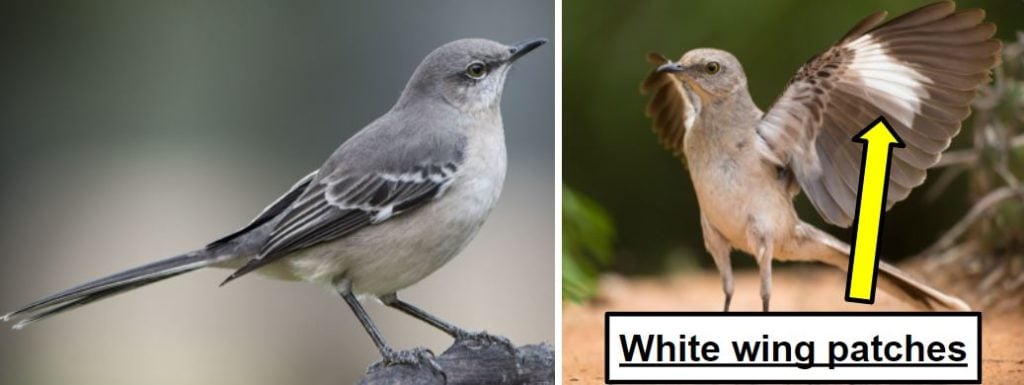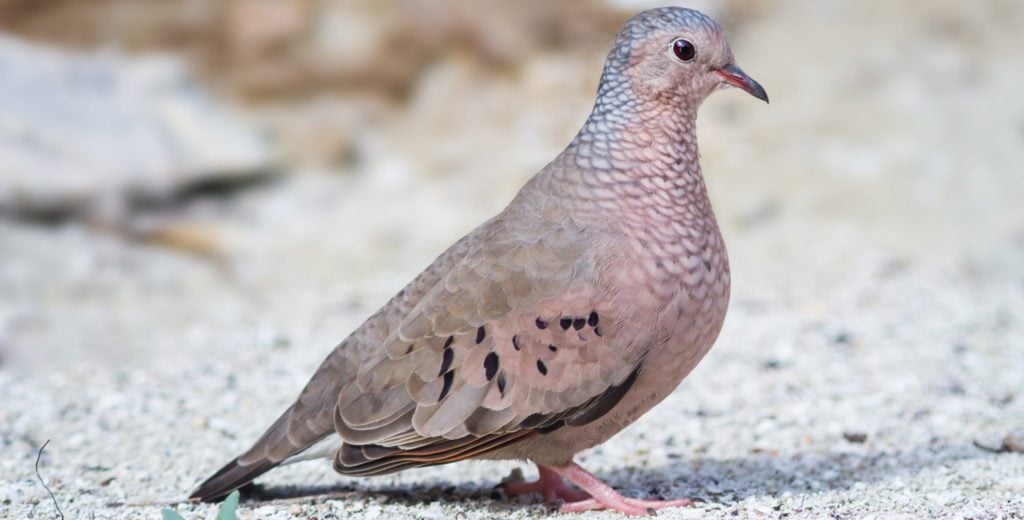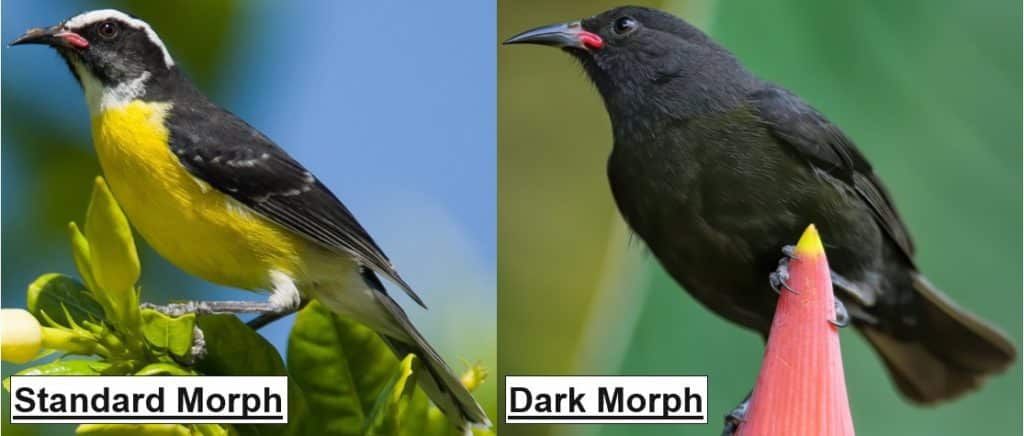13 Types of BIRDS Found on Turks and Caicos! (COMMON)
Below you will find 13 COMMON BIRDS that live in Turks and Caicos!

Believe it or not, over 170 species have been observed here, including many birds that only visit during migration. Because of the incredible variety, it would be impossible to list EVERY single type below.
So I did my best to come up with a list of the birds that are seen the MOST. Enjoy! 🙂
Common Birds of Turks and Caicos:
#1. Yellow-crowned Night Heron
- Nyctanassa violacea

Identifying Characteristics:
- Gray body and yellow legs. Large red eyes.
- Black face with white cheeks and a thick black bill.
- As the name suggests, a yellowish-white crown with long white plumes.
These birds look for areas in Turks and Caicos with shallow water to live in, such as wooded swamps, marshes, mangroves, and other coastal areas. Yellow-crowned Night-Herons can be found near both fresh and saltwater, and crustaceans (crabs and crayfish) make up most of their diet.
They are comfortable living near humans and will even nest in wooded neighborhoods or rooftops. Also, they are usually easy to see because Yellow-crowned Night-Herons eat and hunt at any time of day.
Upon being disturbed, you will hear a harsh “quawk,” which will probably be repeated a few times. Listen below:
#2. Ruddy Turnstone
- Arenaria interpres

Identifying Characteristics:
- Breeding males have a chestnut and black pattern on the back, similar to a calico cat.
- They have orange legs, which are brighter during the breeding season.
Ruddy Turnstones occupy different habitats each season. They nest along rocky coasts in the Arctic during the breeding season. While migrating, they visit plowed fields and shorelines of lakes. Finally, they congregate on rocky shorelines and beaches in the winter.
These beautiful shorebirds have a unique feeding style that earned them their name. They insert their bills under stones, shells, and other objects, flipping them over to find food underneath. Several Ruddy Turnstones may work together to flip a large object.
They will also probe under seaweed and other debris. Their low center of gravity and special feet with short, sharply curved toenails allow them to walk easily on wet and slippery rocks. WATCH BELOW!

#3. Green Heron
- Butorides virescens

Identifying Characteristics:
- Small heron with a long, dagger-like bill.
- Their back is gray-green. Head and neck are chestnut-brown, except for the green-black cap on the head.
- The neck is commonly drawn into their body.
This small heron is found in Turks and Caicos in any wet habitat that includes lots of vegetation, which provides places for them to stay hidden. You will most often see them foraging at dawn or dusk, as they prefer to stay out of sight during most of the day.

Green Herons are ambush predators and mainly eat fish, waiting patiently for a small one to swim by so they can snap it up with their long bill. Interestingly, these birds actually use tools to help them hunt! They will drop insects, feathers, or other items into the water, which entice small fish to come closer to investigate.
The first time I heard the “skeow” call of an alarmed Green Heron, I had no idea what I heard because it was so unique. But luckily, these sounds are easy to learn, and now I can easily identify these herons when I’m visiting most wetlands.
#4. Great Egret
- Ardea alba

Identifying Characteristics:
- Large, white bird with long, black legs.
- S-curved neck and a dagger-like yellow bill. Look for a greenish area between their eyes and the base of the bill.
- While they fly, their neck is tucked in, and their long legs trail behind them.
Great Egrets are one of the most stunning birds in Turks and Caicos.
These herons especially put on a show during breeding season when they grow long feathery plumes called aigrettes, which are held up during courtship displays.
These aigrettes are so beautiful that Great Egrets were almost hunted to extinction in the 19th century because these feathers made such nice decorations on ladies’ hats. The National Audubon Society was formed in response to help protect these birds from being slaughtered. To this day, the Great Egret serves as the organization’s symbol.

#5. Laughing Gull
- Leucophaeus atricilla

Identifying Characteristics:
- Adults range from 39-46 cm (15.3-18.1 in) in length and have a 92-120 cm (36.2-47.2 in) wingspan.
- Adults are medium gray above and white below with reddish-black legs.
- Summer adults have a crisp black hood, white arcs around the eyes, and reddish bills, and in winter, the hood becomes a blurry gray mask on a white head.
Laughing Gulls are typically spotted in Turks and Caicos in coastal areas like beaches, salt marshes, and mangroves.
Like many other gulls, Laughing Gulls are adept at foraging while walking, wading, swimming, or flying. Their food sources include crustaceans, insects, squid, human refuse, berries, fish, earthworms, snails, and the eggs of horseshoe crabs.
These gulls steal food from Brown Pelicans by landing on their heads and taking fish from their bill pouch. I’m sure the Brown Pelicans aren’t laughing when that happens!

#6. Caribbean Flamingo
- Phoenicopterus ruber

Also known as the American Flamingo.
Identifying Characteristics:
- Reddish-pink plumage.
- They measure from 120 to 145 cm (47 to 57 in) tall.
- The bill is white and pink with a large black tip.
These large birds are unmistakable in Turks and Caicos!
The best places to find Caribbean Flamingoes are in shallow, saline lagoons. Like all flamingoes, they have a specialized beak, which is hooked downward, perfect for finding and filtering food in these habitats. Some common food items include small crustaceans, mollusks, some worms, nematodes, insects and their larvae, small fish, etc.
Despite their beauty, Caribbean Flamingoes sound just like geese! Listen below:
#7. Northern Mockingbird
- Mimus polyglottos

Identifying Characteristics:
- Medium-sized grey songbird with a LONG, slender tail.
- Distinctive white wing patches that are visible when in flight.
These birds are hard to miss in Turks and Caicos!
First, Northern Mockingbirds LOVE to sing, and they almost never stop. Sometimes they will even sing through the entire night. If this happens to you, it’s advised to keep your windows closed if you want to get any sleep. 🙂
In addition, Northern Mockingbirds have bold personalities. For example, they commonly harass other birds by flying slowly around them and then approaching with their wings up, showing off their white wing patches.
#8. Common Ground Dove
- Columbina passerina

Identifying Characteristics:
- These doves are small, being only slightly larger than a sparrow!
- They have a plain grey-brown back. The underparts have a pinkish tint to them.
- Small heads with a scaled pattern on their breast and neck. Dark spots on the wings.
Common Ground Doves are typically easy to find in Turks and Caicos. Look for them feeding on the ground beneath bird feeders, cleaning up the grains and other seeds that fall from above.
These doves primarily nest on the ground! Simple nests are built lined with a few types of grass, weeds, and other plant matter. Being on the ground, they can make an easy meal for many predators. Their primary defense is to blend into their surroundings and thick vegetation.
Common Ground Doves are relatively vocal. They can be heard at all times of the day and at any time of the year. Listen for a repeated, soft, high-pitched coo with a rising inflection.
#9. Brown Pelican
- Pelecanus occidentalis

Identifying Characteristics:
- Brown skin on their giant throat patch.
- Dark gray bodies with a white neck and pale yellow head.
- Measures 3.5 – 5 feet in length (1 to 1.5 m) with a wingspan of 6.5 – 7.5 feet (2 to 2.3 m). The weight of adults can range from 4.4 to 11.0 lb (2 to 5 kg).
If you see a pelican in Turks and Caicos while sitting on a beach, it is most likely a Brown Pelican. These large birds live strictly in saltwater habitats near the ocean’s coastline. Interestingly, they rarely venture into the open ocean, staying within 20 miles of the shore.
It’s a lot of fun watching Brown Pelicans hunting for fish! First, they fly high into the sky and then plunge aggressively headfirst into the water. These dives are meant to stun the surrounding fish, which then are scooped up with their enormous throat pouch and swallowed whole.
Check out the below video to learn more about their insane dives!

And lastly, they birds live a long time. The oldest Brown Pelican on record was 43 years of age!
#10. American Kestrel
- Falco sparverius

The American Kestrel is the smallest bird of prey in Turks and Caicos.
But don’t let the tiny stature fool you because this raptor is an accomplished hunter. One of their favorite strategies to catch prey is to hover in the breeze from a relatively low height, looking for insects, invertebrates, small rodents, and birds.
Their diverse diet is one reason they can occupy ecological niches from central Alaska down to the southernmost tip of South America. But life can be tough when you’re the smallest falcon since they are sometimes eaten as prey by larger raptors and big snakes!
#11. Bananaquit
- Coereba flaveola

Identifying Characteristics:
- Adults range from 10-13 cm (4-5 in) long.
- Most adults have dark gray upperparts, a black crown, and a yellow chest, belly, and rump.
Bananaquits have something in common with many humans I know – a sweet tooth! Also known as “sugar birds” in Turks and Caicos, this species is attracted to nectar feeders and bowls of sugar. They even enter homes looking for sweet treats.
Bananaquits are small, colorful, and known for adapting easily to human habitats. They like fruit and nectar, so they spend a lot of time near humans near flower gardens or fruit trees.
This species’ reliance on humans doesn’t stop with their diet. They often build their nests on human-made objects, including lampposts and garden trellises. Look for a globe-shaped tangle of sticks and leaves between 5 and 30 feet (1.5 to 9 m) off the ground.
#12. Royal Tern
- Thalasseus maximus

Identifying Characteristics:
- Adults range from 45-50 cm (17.7-19.7 in) in length and have a 100-110 cm (39.4-43.3 in) wingspan.
- Breeding adults are gray below and white above.
- They have a black crest and a bright orange bill.
Royal Terns spend their lives in warm coastal waters. They’re frequently spotted in sheltered areas with shallow water, such as estuaries, bays, lagoons, and sandy beaches. They occasionally travel out to sea or inland, especially when feeding young, but stay within 80 km (50 mi) of the coast.
Breeding pairs of Royal Terns choose a site and build their nests together. The nests are simple scrapes in the earth. But, they have an unusual way of strengthening their nests. They defecate around the rim of the nest, and as it hardens, it reinforces the nest rim and helps keep it from flooding.
#13. Gray Kingbird
- Tyrannus dominicensis

Identifying Characteristics:
- Grayish bird with a whitish belly.
- Dark mask on the face that goes through the eye and cheek.
- Tail typically appears notched.
These birds are a lot of fun to watch in Turks and Caicos!
Gray Kingbirds are bold and expert hunters. They are known to chase dragonflies and other insects for over a hundred yards in spectacular fashion, reminiscent of a fighter pilot!
Gray Kingbirds are fairly easy to find due to their raucous and memorable voice. Listen for a rolling pitirre call anytime throughout the year.
Which of these birds have you seen before in Turks and Caicos?
Leave a COMMENT below! 🙂

